You could consider the article about the Minolta MD 24-35mm f3.5 as a teaser because, even though it’s a fantastic lens, Minolta has more gems in store for those who know how to find them. And that’s what this sequel is about.
There is also that unmistakable link with Leica. So, specifically for photographers who value Leica lenses but operate within a budget that doesn’t match the high costs of authentic Leica products. In such instances, this alternative isn’t just the “next best thing”; it offers the same quality, albeit with a different brand name and price tag. But is all of this really true? Let’s find out!
The journey began with a quest for an affordable Leica lens. Typically, Leica lenses are quite pricey, often reaching several thousand euro/dollars/pounds. However, I came across information indicating that Leica R lenses – lenses designed for Leica SLR-type cameras – are significantly more affordable, ranging from a few hundred euros to a maximum of a thousand. Digging deeper into the history of Leica and the Leica R series, I read the intriguing fact that some of these lenses weren’t manufactured by Leica at all, but at Minolta’s Lens Factory !
Leica purists may be reluctant to accept this, but it’s a fact that Leica and Minolta collaborated, with Minolta producing lenses for Leica. In the case of Leica R lenses, this encompassed the 16mm, 24mm, 70/210mm, and also the 35-70mm. For the Leica M series, Minolta contributed the 28mm, 40mm, and 90mm. However, aside from the 35-70mm, there’s no documentation suggesting that Minolta provided fully assembled lenses for Leica; instead, they supplied lens glass. Minolta also employed its own unique lens coatings, distinct from those used by Leica. Despite maintaining the highest quality standards and boasting some exceptional lens designs, no Minolta lens, except perhaps the 35-70mm, is identical to a Leica lens, and vice versa. Nevertheless, there’s no other brand that comes as close to Leica’s quality, and in some instances, it may even surpass it, though opinions on this are subjective.
Now is the time to see that piece of history and passion come to life, because personally, I don’t think I’ve come across anyone who can capture that passion better than Justin Phillip in his ‘Camera Company that Rocked the Industry – Minolta vs Leica‘ , at least if you have about 13 minutes, if not, just read on…
It is the personal sentiment, the collaboration between Leica and Minolta, and the exchange of expertise and materials within a specific production time frame, that lead some reviewers to passionately prefer a particular Minolta lens series, more specifically: the Minolta MC Rokkor Mark III series, because it most closely resembles its Leica counterpart. However, this does not mean that other Minolta lens series are sub-par. That said, when we talk about achieving the highest build quality, delivering the best results on full-frame cameras and delivering the sharpest image right to the edges, then the MC Rokkor Mark III version is indeed the optimal choice. .
A Minolta MC W. Rokkor 28mm f2.8 MKIII is a wise choice for your initial lens purchase and serves as a great foundation for a Rokkor lens collection. This lens offers a field of view equivalent to that of a 56mm lens on a M4/3 camera. Surprisingly, my first Minolta lens wasn’t the 24-35mm; instead, it was the 28mm that persuaded me to further invest in a Minolta lens kit. You might be curious why not a 24mm? Well, while that would have been more intriguing, however, it also comes with a significantly higher price tag – and that is where the 24-35mm zoom lens offered a great alternative.
Buying a Minolta Rokkor 28mm lens turned out to be more complex than I initially thought. There are 25 different versions of this specific 28mm lens for SLRs, all very looking alike, with prices varying widely, and not all of them are equally good.
And once again, it’s Justin Phillip who (in his special way) provides insight in his ‘Best Vintage Lenses for Price & Character‘ focusing on the purchase of Minolta Rokkors, with the emphasis always directed towards video production. This video lasts 37 minutes. If you’re not interested or want come back to it later, continue reading …
There are also Rokkors designed for Leica M mount, which may seem more appealing because they can use a shorter adapter, but they also come with a higher price tag. Moreover, many of the 28mm Rokkors for Leica M suffer from white dots on the lens glass surface – not mold, but Schneideritis, related to the paint coating inside the lens. I recommend avoiding these and opting for the SLR type.
It is essential to collect information beforehand to understand what to search for. I suggest checking out the provided links for this purpose. After reviewing them, you will be well-equipped to make a purchase. If you’re not keen on watching videos, these two web links below are essential for identifying the right lenses :
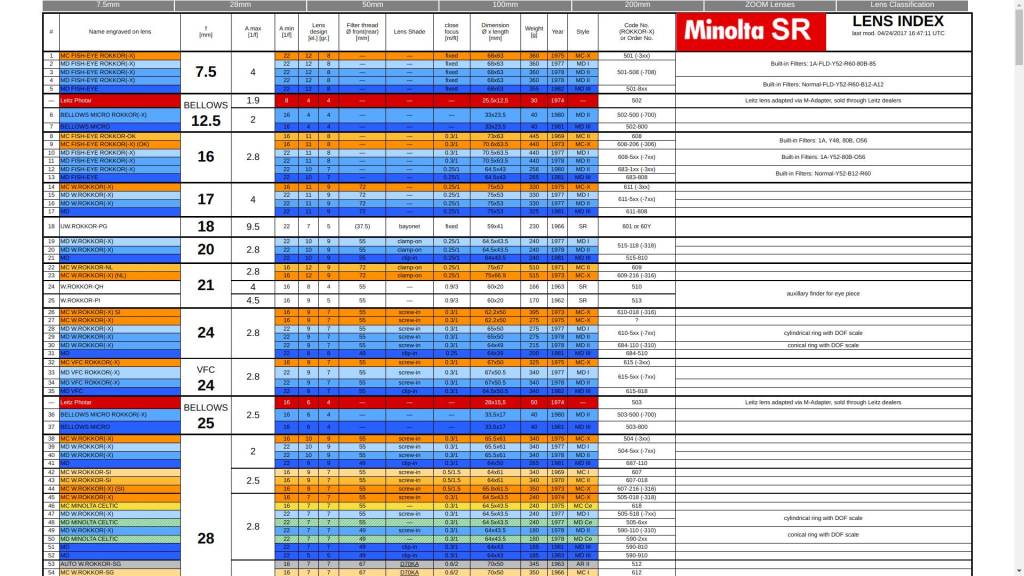
The initial element is a table by Dennis Lohmann, presenting the different versions produced for a specific lens. In my article, I focus on the 28mm lens. The table provides a comprehensive overview of the various iterations and includes essential lens details like the maximum and minimum aperture, filter diameter, dimensions, and weight. These details are crucial for accurate identification. -> Minolta manual lens list
You can discover a comprehensive collection of photos featuring the Minolta 28mm lens and its various models on Add Dieleman‘s website. There is no easier way to visually identify a lens. Additionally, the website includes photos of numerous other Minolta lenses, along with interesting links where you can find more information about Minolta -> Ad Dieleman’s Collection of Minolta SR, MC, MD mount lenses
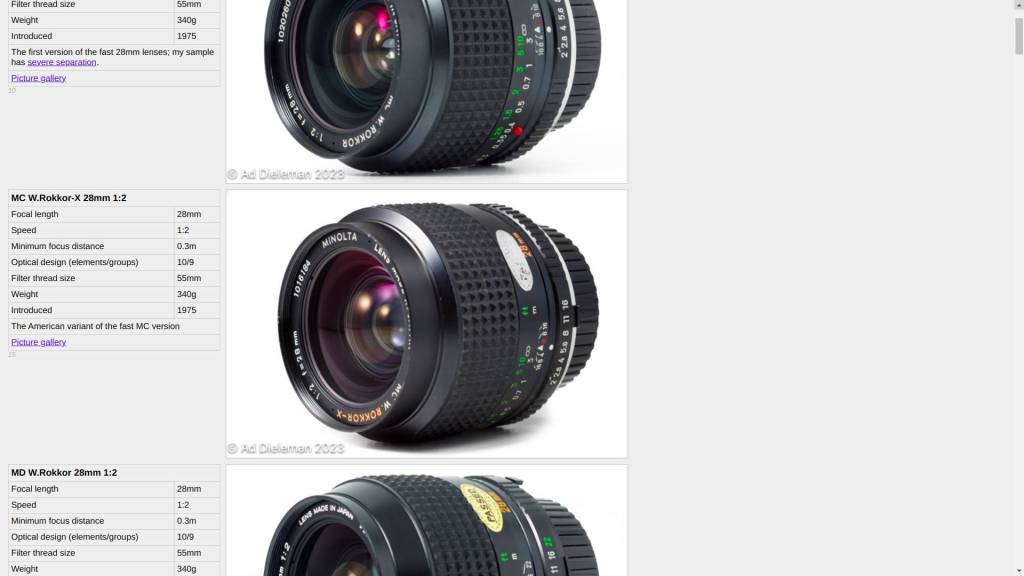
Summarized – the better 28mm versions :
The Best : Minolta MC W. Rokkor 28mm f2.8 MKIII
(orange on Minolta manual lens list)
- Full Metal lens with rubber waffeled grip
- 55mm Filter thread
- MC Rokkor on front of the lens – Rokkor X is also OK (North America)
- Aperture only in white letters
- Silver ring at bottom of lens
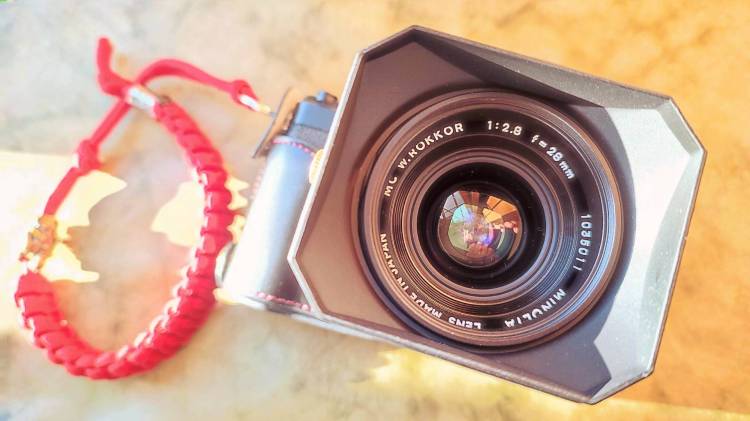
My version is the 1975 first edition f2.8 after the f2.5, and weighs 240gr, there is a second version that looks identical and weighs 205gr (also Rokkor-X)
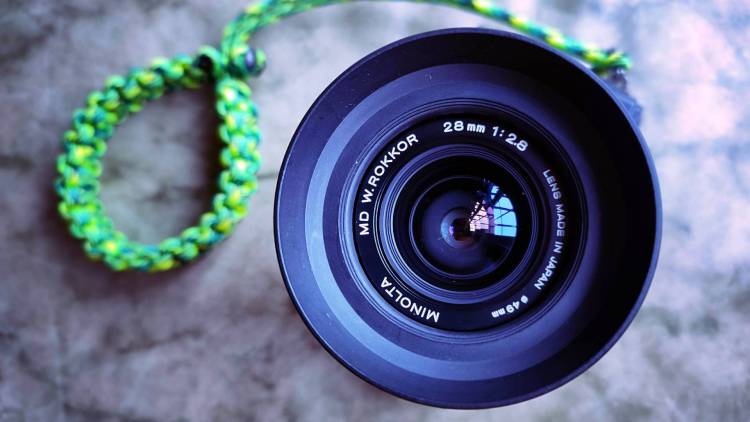
Minolta MD W. Rokkor 28mm f2.8 MKII version is second best
- All plastic lens with waffeled grip
- 49mm Filter thread
- Smallest f number painted green
- MD Rokkor on front of lens
The version I have is the 1978 model, featuring a more compact design, weighing 180 grams, equipped with a large four-row rubber-waffled ring and a conical aperture ring.
In a subsequent article, I will provide a review of both versions mentioned above, both of which I personally purchased. Initially, I acquired the MD version, but later on, when I had the opportunity to purchase the MC version at a favorable price, I was genuinely curious to explore the actual differences these lenses offer to a photographer.
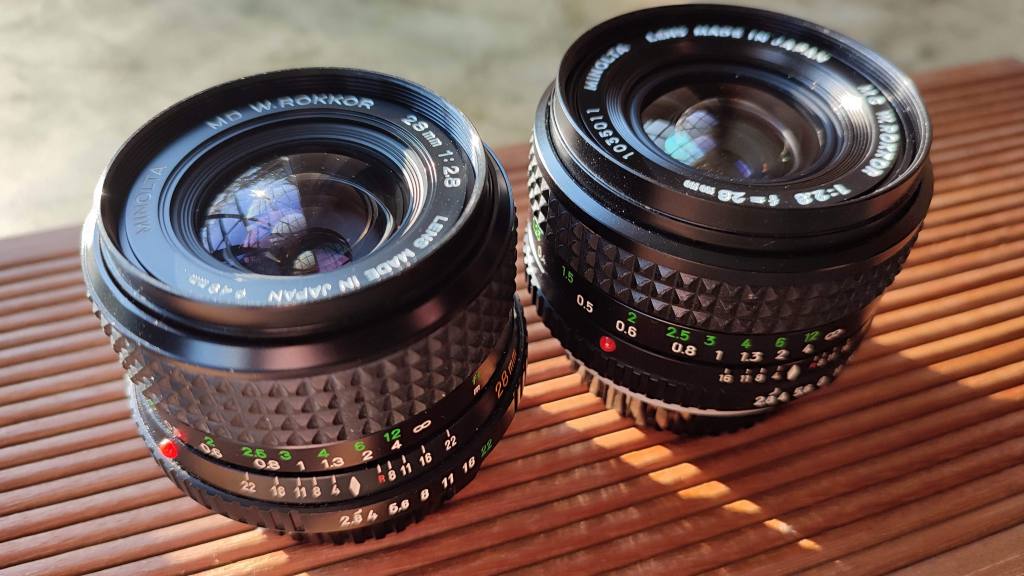
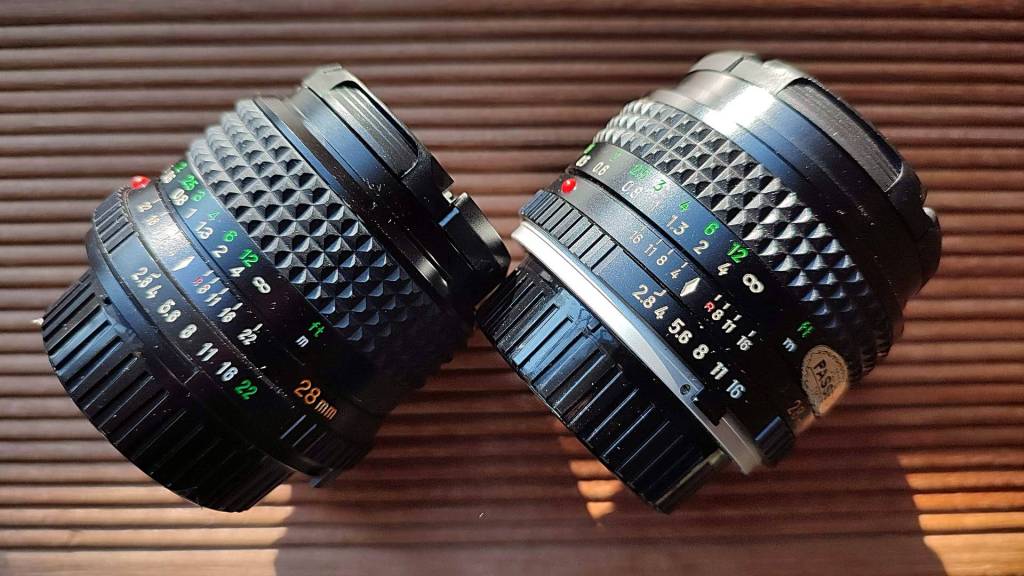
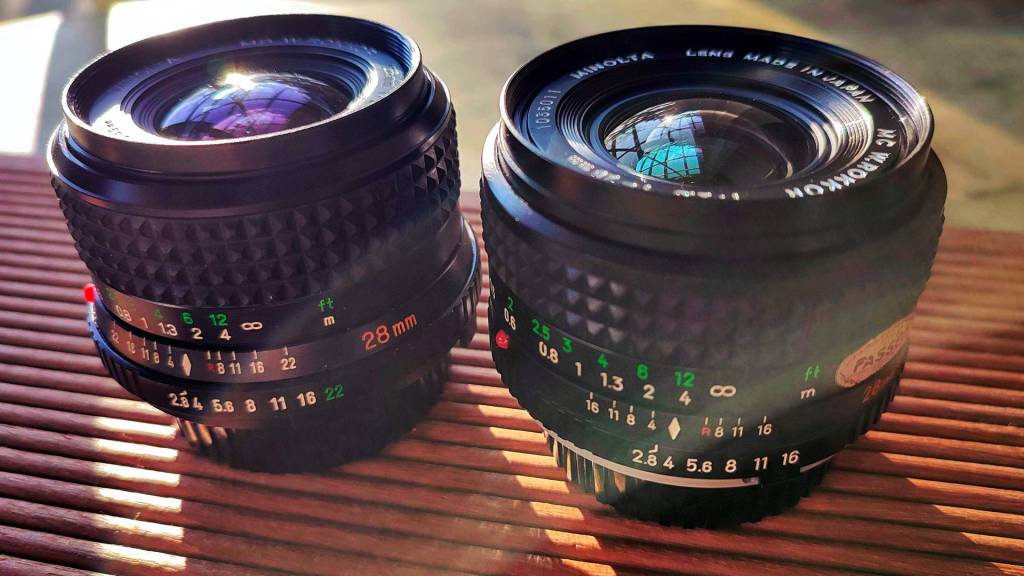
For those interested in what I paid for these lenses, well, you have to keep track a bit and not just buy the first one that comes along, as I did myself. My initial purchase was on eBay for the 28mm MD lens at €90 – an average price, then later on a local second-hand site, I bought the better 28mm MC along with the MD 35-70mm for €68 – cheap for either one, and I got two for the price of one 🙂 . So, it pays off to shop around a bit and not jump in too quickly.
The sales price is, depending on the external condition of the lens, scratches and haze, included original accessories such as original front and rear caps, lens hood, leather case or original packaging :
Minolta MD W. Rokkor 28mm f2.8 MKII = €50 – €100
Minolta MC W. Rokkor 28mm f2.8 MKIII = €100 – €250
About the other versions :
Are all 25 variations of the 28mm f2.8 lens bad, except for one? Well, I believe that the later MD versions without the Rokkor designation are likely acceptable too. However, it’s important to note that these versions might have lower build quality and possibly less overall or edge sharpness. In the end, the purpose of this article is to pinpoint the best of the best, the ones that embody the essence of Leica.
Radio Active versions :
All 28mm versions with an aperture of f2.5 are equipped with Thorium Glass, which is radioactive. Since I already emit sufficient light, I prefer to avoid them 🙂
Info about abbreviations and adapters :
- The abbreviation MC does not mean Multi Coating (which you might expect) but “Meter Coupled”
- The abbreviation MD is a step up from MC lenses, and was used for Program or shutter priority modes on Minolta X cameras (XD11, X700) – Please note: MD step up does not mean that the lens is optically better than the MC, because it is not
Also confusing what people and adapter company’s say, is the Minolta M, MC or MD mount :
- Minolta M mount is actually Leica M mount, used on Leica CL and Minolta CLE cameras – FFD = 27.80mm (rangefinder) – A more correct name for Minolta lenses in this type, and usually used as such on eBay for example, is Minolta CLE mount
- Minolta MC or MD mount is actually SR mount, used on mirror reflexes – FFD = 43.50mm (SLR)
Adapters that you can buy with the designation MD-M4/3 are actually adapters SR-M4/3 and are therefore 24.25 mm long (for MFT) – a Minolta SR bayonet mount has three lips.
An adapter for Minolta CLE lenses is the same as for Leica M, and has a length of 8.55mm (for MFT) – Leica M and therefore also Minolta CLE have a bayonet with four lips
If you’ve gone through all of this and are interested in additional history and reviews about Minolta Rokkors, please check out Antony‘s website, ‘The Rokkor Files‘.
Are you interested in a specific Minolta lens and seeking a highly detailed review that focuses on sharpness and details? In that case, I highly recommend checking out the website of Ilya Kuvshinov ‘Lens QA Works‘.
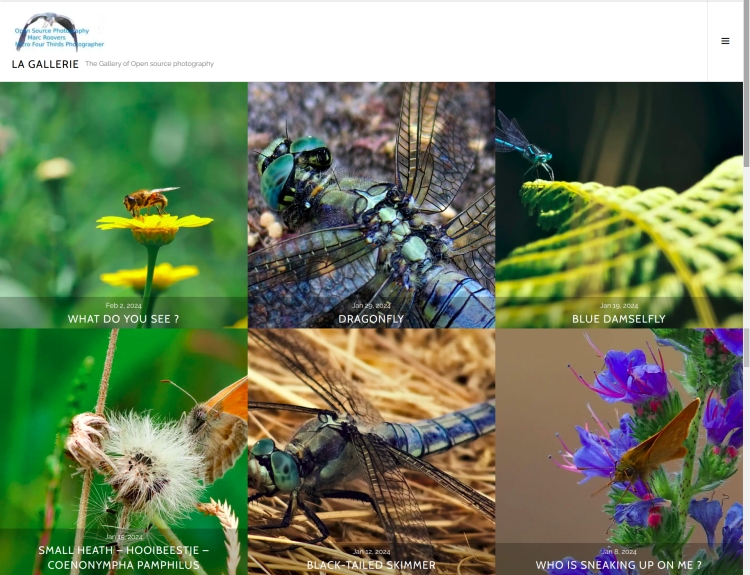
The photo gallery of Open Source Photography, Olympus micro 4/3 system, Vintage Lens Photograpy, Film Simulation, PictureFX, HDR – Photographer : Marc R.
Discover more from Open Source Photography
Subscribe to get the latest posts sent to your email.


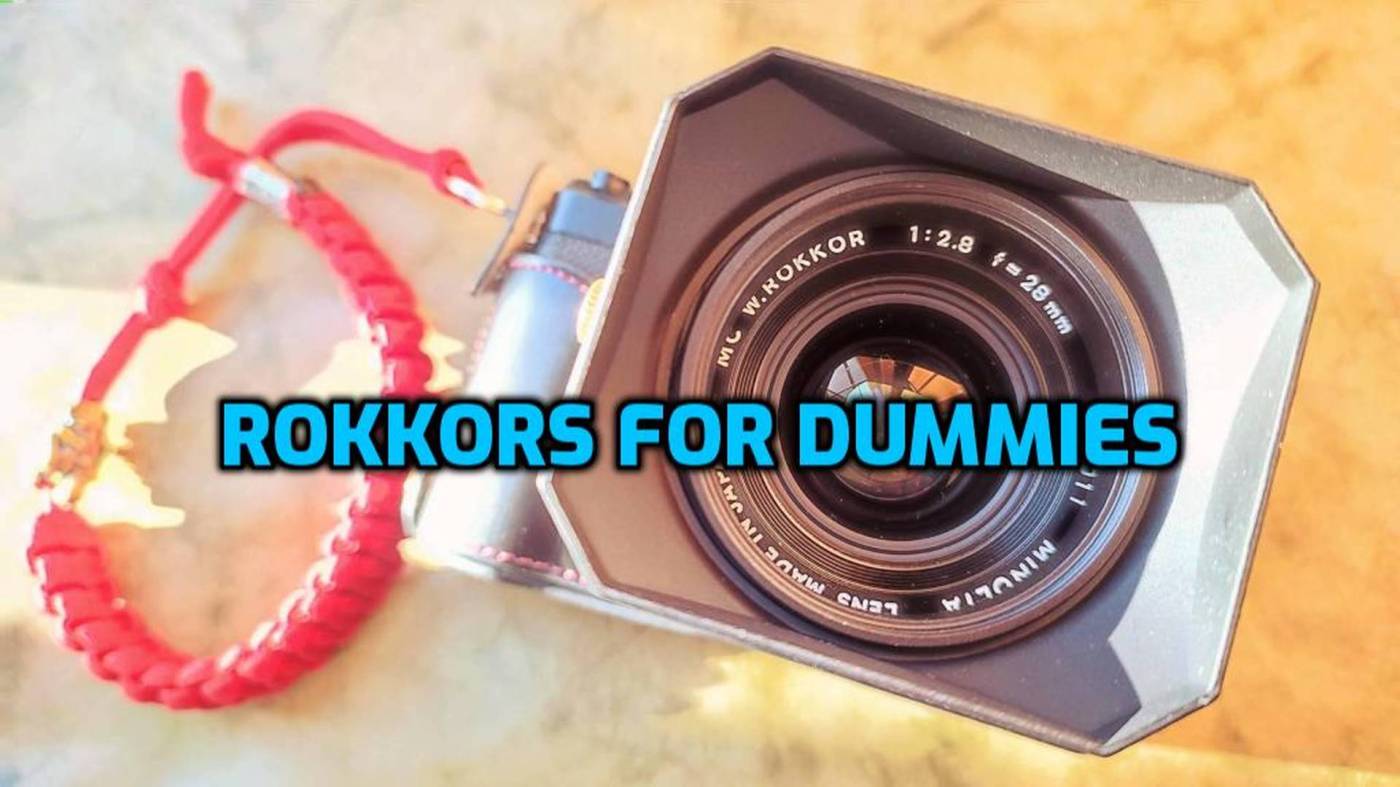

This a very interesting and informative article Marc I had no idea about their collaboration! Definitely food for thought when buying vintage lenses.
LikeLike
Thanks Mark! and especially on a full frame, those vintage lenses are so much fun, just like the old days and without that annoying crop factor from APS-C cameras.
LikeLiked by 1 person
I have kept my Yashica 50 F2 and I’m going to get an adaptor soon for it.
LikeLiked by 1 person